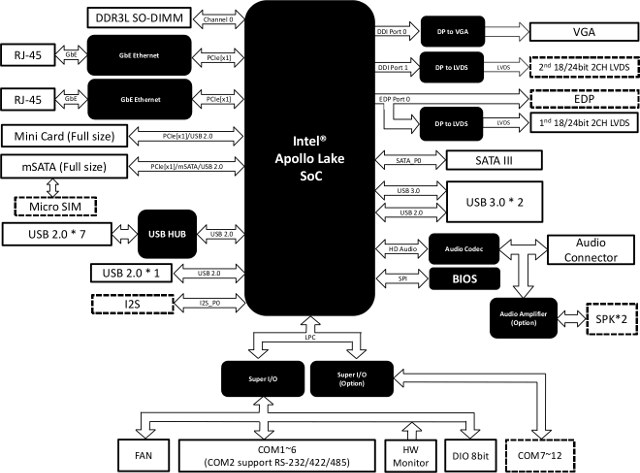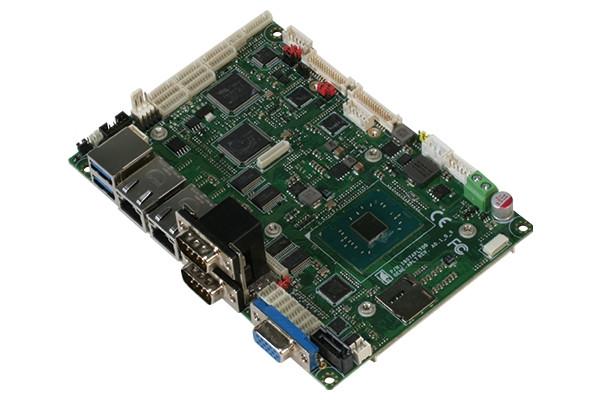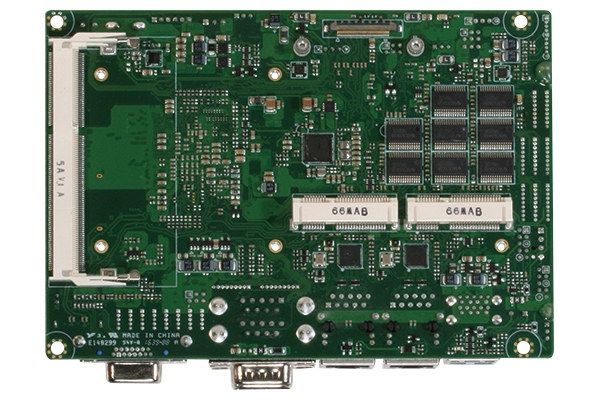If you have an application requiring a relatively powerful – yet low power – and compact platform, and plenty of USB and/or serial ports (COM ports), AAEON GENE-APL7 might just be ideal.
The 3.5″ subcompact board is powered by an Intel Pentium N4200 or Celeron N3350 processor with a SO-DIMM slots, some video/display outputs, two USB 2.0 ports, eight USB 2.0 interfaces, and up to 12 COM ports.
AAEON GENE-APL7 board specifications:
- SoC (one or the other)
- Intel Pentium N4200 quad core Apollo Lake processor @ with Intel HD Graphics; 6W TDP
- Intel Celeron N3350 Apollo Lake processor with Intel HD Graphics; 6W TDP
- System Memory – 1x DDR3L-1866MHz SODIMM up to 8GB
- Storage – SATA 3.0 interface, 1x mSATA slot (full size) for SSD
- Video Output / Display I/F
- VGA, 2-ch 24-bit LVDS1, optional LVDS2/eDP
- 12V/2A backlight inverter supply
- Audio – High Definition Audio Interface, optional 2W Amplified
- Connectivity – 2x Gigabit Ethernet (Realtek RTL8111E); optional Micro SIM for mPCIe cellular modem
- USB
- 2x USB 3.0 type A ports
- 8x internal USB 2.0 headers
- Serial
- 2x COM ports (DB9; RS-232/422/485)
- 4x internal COM/serial headers with support for 5V/12V/RI, optional support for up to 10 internal COM ports.
- Expansion
- 1x mPCIe Mini-card (Full size)
- 8-bit DIO
- Power Supply – 12V Only; AT/ ATX
- Power Consumption (Typical) – Intel N4200,DDR3L 1600MHz 8G, 1.16A@ +12V
- Dimension (L x W) – 146 mm x 101.7 mm(3.5” SubCompact Board)
- Temperature Range – Operating: 0°C ~ 60°C; storage: -40°C ~ 85°C
- Humidity – 0% ~ 90% relative humidity, non-condensing
- MTBF- 126,058 hours
- Certification – CE/FCC

The company does not list supported operating systems, but based on the drivers list and user’s manual, they support Windows 7/8.1/10 64-bit for the board. No word about Linux support, so you’d have to double check with the company for Linux distributions.
In case – like me – you wonder which type of applications may need that number of USB and serial ports, AAEON claims the board is “for use in the retail and fintech sectors” which may mean point-of-sales and ATMs.
Visit the product page for more details including links to datasheet and user manual, as well as Windows drivers. The board has just been launched at an undisclosed price together optional accessories like heatsink, RTC battery, and various cables.


Jean-Luc started CNX Software in 2010 as a part-time endeavor, before quitting his job as a software engineering manager, and starting to write daily news, and reviews full time later in 2011.
Support CNX Software! Donate via cryptocurrencies, become a Patron on Patreon, or purchase goods on Amazon or Aliexpress






